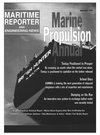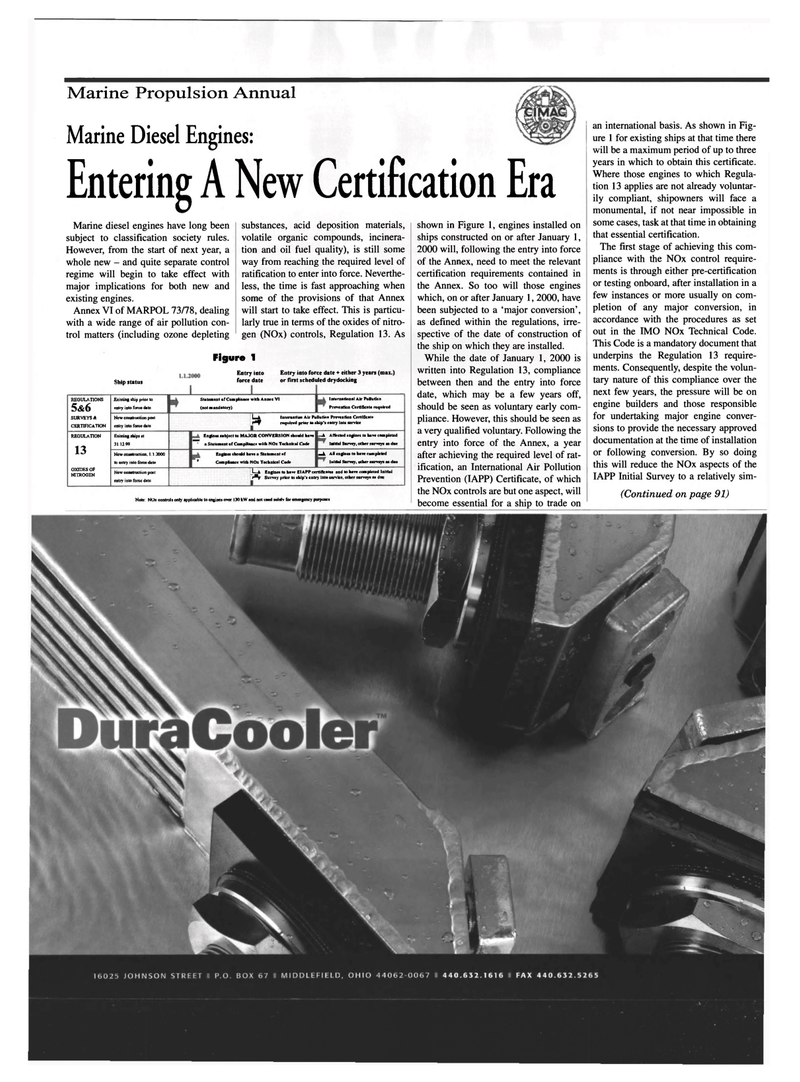
Page 76: of Maritime Reporter Magazine (September 1999)
Read this page in Pdf, Flash or Html5 edition of September 1999 Maritime Reporter Magazine
Marine Propulsion Annual
Marine Diesel Engines:
Entering A New Certification Era
Marine diesel engines have long been subject to classification society rules.
However, from the start of next year, a whole new - and quite separate control regime will begin to take effect with major implications for both new and existing engines.
Annex VI of MARPOL 73/78, dealing with a wide range of air pollution con- trol matters (including ozone depleting substances, acid deposition materials, volatile organic compounds, incinera- tion and oil fuel quality), is still some way from reaching the required level of ratification to enter into force. Neverthe- less, the time is fast approaching when some of the provisions of that Annex will start to take effect. This is particu- larly true in terms of the oxides of nitro- gen (NOx) controls, Regulation 13. As
Figure 1
Ship status
Entry into force date
Entry into force date + either 3 years (max.) or first scheduled drydocking
REGUUlTIONS 5&6
SURVEYS &
CERTIFICATION
Existing ship prior to entry into force date
Statement of Compliance (not mandatory) with Anne* VI International Air Pollution
Prevention Certificate required
New construction post entry into force date
LA (ntemation Air Pollution Prevention Certificate r*f required prior to ship's entry into service
REGULATION 13
OXIDES OF
NITROGEN
Existing ships at 31.12.99
Engines subject to MAJOR CONVERSION should have ™ a Statement of Compliance with NO* Technical Code —A Affected engines to have completed
Initial Survey, other surveys as due
New construction. 1.1.2000 to entry into force date
Engines should have a Statement of ' Compliance with NO* Technical Code
BA All engines to have completed
Initial Survey, other surveys as due
New construction post entry into force date
L_X Engines to have EIAPP certificates and to have completed Initial r^f Survey prior to ship's entry into service, other surveys as due
Note: NOx control! only ipplictblc to engines over 130 kW and not used soleh for emergency purpose! shown in Figure 1, engines installed on ships constructed on or after January 1, 2000 will, following the entry into force of the Annex, need to meet the relevant certification requirements contained in the Annex. So too will those engines which, on or after January 1, 2000, have been subjected to a 'major conversion', as defined within the regulations, irre- spective of the date of construction of the ship on which they are installed.
While the date of January 1, 2000 is written into Regulation 13, compliance between then and the entry into force date, which may be a few years off, should be seen as voluntary early com- pliance. However, this should be seen as a very qualified voluntary. Following the entry into force of the Annex, a year after achieving the required level of rat- ification, an International Air Pollution
Prevention (IAPP) Certificate, of which the NOx controls are but one aspect, will become essential for a ship to trade on an international basis. As shown in Fig- ure 1 for existing ships at that time there will be a maximum period of up to three years in which to obtain this certificate.
Where those engines to which Regula- tion 13 applies are not already voluntar- ily compliant, shipowners will face a monumental, if not near impossible in some cases, task at that time in obtaining that essential certification.
The first stage of achieving this com- pliance with the NOx control require- ments is through either pre-certification or testing onboard, after installation in a few instances or more usually on com- pletion of any major conversion, in accordance with the procedures as set out in the IMO NOx Technical Code.
This Code is a mandatory document that underpins the Regulation 13 require- ments. Consequently, despite the volun- tary nature of this compliance over the next few years, the pressure will be on engine builders and those responsible for undertaking major engine conver- sions to provide the necessary approved documentation at the time of installation or following conversion. By so doing this will reduce the NOx aspects of the
IAPP Initial Survey to a relatively sim- (Continued on page 91)

 75
75

 77
77
